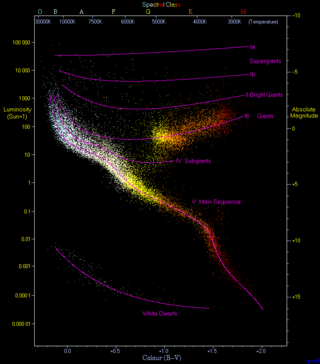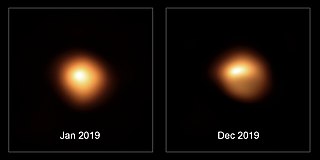
Algol, designated Beta Persei, known colloquially as the Demon Star, is a bright multiple star in the constellation of Perseus and one of the first non-nova variable stars to be discovered.

In astronomy, the main sequence is a classification of stars which appear on plots of stellar color versus brightness as a continuous and distinctive band. Stars on this band are known as main-sequence stars or dwarf stars, and positions of stars on and off the band are believed to indicate their physical properties, as well as their progress through several types of star life-cycles. These are the most numerous true stars in the universe and include the Sun. Color-magnitude plots are known as Hertzsprung–Russell diagrams after Ejnar Hertzsprung and Henry Norris Russell.

A star is a luminous spheroid of plasma held together by self-gravity. The nearest star to Earth is the Sun. Many other stars are visible to the naked eye at night; their immense distances from Earth make them appear as fixed points of light. The most prominent stars have been categorised into constellations and asterisms, and many of the brightest stars have proper names. Astronomers have assembled star catalogues that identify the known stars and provide standardized stellar designations. The observable universe contains an estimated 1022 to 1024 stars. Only about 4,000 of these stars are visible to the naked eye—all within the Milky Way galaxy.

Stellar evolution is the process by which a star changes over the course of its lifetime and how it can lead to the creation of a new star. Depending on the mass of the star, its lifetime can range from a few million years for the most massive to trillions of years for the least massive, which is considerably longer than the current age of the universe. The table shows the lifetimes of stars as a function of their masses. All stars are formed from collapsing clouds of gas and dust, often called nebulae or molecular clouds. Over the course of millions of years, these protostars settle down into a state of equilibrium, becoming what is known as a main-sequence star.

A binary star or binary star system is a system of two stars that are gravitationally bound to and in orbit around each other. Binary stars in the night sky that are seen as a single object to the naked eye are often resolved as separate stars using a telescope, in which case they are called visual binaries. Many visual binaries have long orbital periods of several centuries or millennia and therefore have orbits which are uncertain or poorly known. They may also be detected by indirect techniques, such as spectroscopy or astrometry. If a binary star happens to orbit in a plane along our line of sight, its components will eclipse and transit each other; these pairs are called eclipsing binaries, or, together with other binaries that change brightness as they orbit, photometric binaries.

A visual binary is a gravitationally bound binary star system that can be resolved into two stars. These stars are estimated, via Kepler's third law, to have periods ranging from a few years to thousands of years. A visual binary consists of two stars, usually of a different brightness. Because of this, the brighter star is called the primary and the fainter one is called the companion. If the primary is too bright, relative to the companion, this can cause a glare making it difficult to resolve the two components. However, it is possible to resolve the system if observations of the brighter star show it to wobble about a centre of mass. In general, a visual binary can be resolved into two stars with a telescope if their centres are separated by a value greater than or equal to one arcsecond, but with modern professional telescopes, interferometry, or space-based equipment, stars can be resolved at closer distances.

A variable star is a star whose brightness as seen from Earth changes systematically with time. This variation may be caused by a change in emitted light or by something partly blocking the light, so variable stars are classified as either:

A stellar wind is a flow of gas ejected from the upper atmosphere of a star. It is distinguished from the bipolar outflows characteristic of young stars by being less collimated, although stellar winds are not generally spherically symmetric.

In astronomy, the Roche lobe is the region around a star in a binary system within which orbiting material is gravitationally bound to that star. It is an approximately teardrop-shaped region bounded by a critical gravitational equipotential, with the apex of the teardrop pointing towards the other star (the apex is at the L1 Lagrangian point of the system).

A blue straggler is a type of star that is more luminous and bluer than expected. Typically identified in a stellar cluster, they have a higher effective temperature than the main sequence turnoff point for the cluster, where ordinary stars begin to evolve towards the red giant branch. Blue stragglers were first discovered by Allan Sandage in 1953 while performing photometry of the stars in the globular cluster M3.

In astronomy, a blue giant is a hot star with a luminosity class of III (giant) or II. In the standard Hertzsprung–Russell diagram, these stars lie above and to the right of the main sequence.

A blue supergiant (BSG) is a hot, luminous star, often referred to as an OB supergiant. They are usually considered to be those with luminosity class I and spectral class B9 or earlier, although sometimes A-class supergiants are also deemed blue supergiants.

A giant star has a substantially larger radius and luminosity than a main-sequence star of the same surface temperature. They lie above the main sequence on the Hertzsprung–Russell diagram and correspond to luminosity classes II and III. The terms giant and dwarf were coined for stars of quite different luminosity despite similar temperature or spectral type by Ejnar Hertzsprung in 1905 or 1906.

The red-giant branch (RGB), sometimes called the first giant branch, is the portion of the giant branch before helium ignition occurs in the course of stellar evolution. It is a stage that follows the main sequence for low- to intermediate-mass stars. Red-giant-branch stars have an inert helium core surrounded by a shell of hydrogen fusing via the CNO cycle. They are K- and M-class stars much larger and more luminous than main-sequence stars of the same temperature.

A subgiant is a star that is brighter than a normal main-sequence star of the same spectral class, but not as bright as giant stars. The term subgiant is applied both to a particular spectral luminosity class and to a stage in the evolution of a star.

Lambda Tauri is a triple star system in the constellation Taurus. In the Calendarium of Al Achsasi Al Mouakket, this star was designated Sadr al Tauri, which was translated into Latin as Pectus Tauri, meaning "the bull chest". In 1848, the light from this system was found to vary periodically and it was determined to be an eclipsing binary system—the third such discovered. The components of this system have a combined apparent visual magnitude of +3.37 at its brightest, making it one of the brighter members of the constellation. Based upon parallax measurements from the Hipparcos mission, the distance to this system is approximately 480 light-years.

Algol variables or Algol-type binaries are a class of eclipsing binary stars that are similar to the prototype member of this class, β Persei. An Algol binary is a system where both stars are near-spherical such that the timing of the start and end of the eclipses is well-defined. The primary is generally a main sequence star well within its Roche lobe. The secondary may also be a main sequence star, referred to as a detached binary or it may an evolved star filling its Roche lobe, referred to as a semidetached binary.
Barium stars are spectral class G to K stars whose spectra indicate an overabundance of s-process elements by the presence of singly ionized barium, Ba II, at λ 455.4 nm. Barium stars also show enhanced spectral features of carbon, the bands of the molecules CH, CN and C2. The class was originally recognized and defined by William P. Bidelman and Philip Keenan. Initially, after their discovery, they were thought to be red giants, but the same chemical signature has been observed in main-sequence stars as well.
A stellar core is the extremely hot, dense region at the center of a star. For an ordinary main sequence star, the core region is the volume where the temperature and pressure conditions allow for energy production through thermonuclear fusion of hydrogen into helium. This energy in turn counterbalances the mass of the star pressing inward; a process that self-maintains the conditions in thermal and hydrostatic equilibrium. The minimum temperature required for stellar hydrogen fusion exceeds 107 K (10 MK), while the density at the core of the Sun is over 100 g/cm3. The core is surrounded by the stellar envelope, which transports energy from the core to the stellar atmosphere where it is radiated away into space.

An O-type star is a hot, blue-white star of spectral type O in the Yerkes classification system employed by astronomers. They have surface temperatures in excess of 30,000 kelvins (K). Stars of this type have strong absorption lines of ionised helium, strong lines of other ionised elements, and hydrogen and neutral helium lines weaker than spectral type B.














